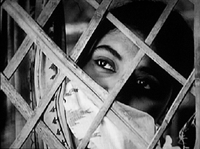In an impoverished refugee village in Calcutta, an attractive and industrious young woman, Nita (Supriya Choudhury), breaks a sandal while passing through the market square, and without complaining, continues barefoot on the graveled street, unable to buy a replacement pair of sandals for the walk home. Patently aware that Nita has received her monthly salary, her talented, but indolent older brother Shankar (Anil Chatterjee) pays an unexpected visit, and encountering Nita absorbed in reading a personal letter from a suitor named Sanat (Niranjan Ray), playfully snatches the note and reads aloud its affectionate contents, before asking her for spending money. Meanwhile her younger sister, Gita (Gita Ghatak) and brother Mantu (Dwiju Bhawal) brazenly plead with their desperate and resourceless mother (Gita De) for new articles of clothing, before re-directing their vain and selfish entreaties to Nita. Having spent her entire salary on her burdensome, coddled siblings, her embittered and insecure mother then vociferously complains to her father (Bijon Bhattacharya), an underemployed school teacher, that Nita has squandered the monthly household budget. Bound by a selfless sense of familial duty, Nita has decided to postpone her marriage to Sanat until Shankar realizes his ambition to become a classical singer. However, as Nita perseveres in her sacrifice for her ungrateful and demanding family, her own prospects for happiness proves ever increasingly bleak.
Ritwik Ghatak presents a visually sublime, idiosyncratically overripe, but provocative and deeply personal account of poverty, disillusionment, and exile in The Cloud-Capped Star. By interplaying light and shadows and incorporating evocative, aggressive sounds that underscore emotional impact and comedic tone, Ghatak creates a unique, sensorial experience that chronicles the systematic demoralization of the human soul: the surreal, foreboding shot of Nita descending a staircase after she is compelled to leave her studies in order to support the family; the overemphasized sounds of cooking as the mother spies on Nita and Sanat that aurally conveys her anger and fear at losing their primary source of income; the contrasted image of Nita – first, illuminated in front of a latticed window as she reads Sanat’s letter and later, concealed behind the window after Shankar’s return; the sound of lashing as Nita and Shankar sing a melancholic Rabindranath Tagore song (evoking Raskolnikov’s dream on burden and responsibility in Fyodor Doestoevsky’s Crime and Punishment). An allegory for the traumatic consequences of the partition of Bengal, The Cloud-Capped Star captures the disintegration of a Bengali middle class family as a result of dislocation, poverty, self-interest, and petty, internal division. Note the repeated imagery of a passing train bisecting the horizon that alludes to the physical division of the family’s ancestral homeland. Inevitably, as Nita attempts to recuperate from the ravages of self-denial, want, and exploitation, her cry of anguish becomes an indistinguishable, resonant echo from the lost and irredeemable soul of a displaced and uprooted people.
© Acquarello 2002. All rights reserved.
